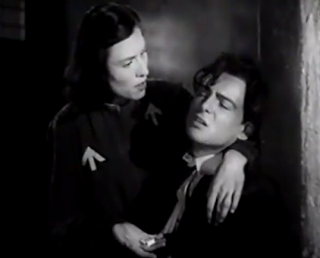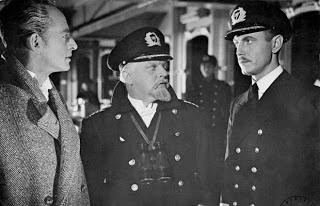
During World War II, Germans needed little persuasion to hate France, their perennial enemy, or the Soviet Union. But England was a different matter: racially akin and similarly imperialistic, the British were widely admired and envied by Germans, including Adolf Hitler. Joseph Goebbels' Propaganda Ministry decided to tackle the issue through cinema.
We reviewed Ohm Kruger (1942) earlier this week. Now to examine two lesser attacks on the same target. Both My Life for Ireland (1941) and Titanic (1943) suffer from crude drama and forced messaging: branding England as greedy, oppressive, murderous monsters. This attack has singularly little merit, as the Nazis outdid Brtain's imperial excesses by orders of magnitude.
 My Life for Ireland was the product of Max W. Kammich, Joseph Goebbels' brother-in-law and specialist in Anglophobe propaganda. He'd already directed The Fox of Glenarvon (1940), an Irish-set melodrama featuring stock villain Ferdinand Marian. Kammich appropriates Ireland's independence struggle for artless Brit bashing.
My Life for Ireland was the product of Max W. Kammich, Joseph Goebbels' brother-in-law and specialist in Anglophobe propaganda. He'd already directed The Fox of Glenarvon (1940), an Irish-set melodrama featuring stock villain Ferdinand Marian. Kammich appropriates Ireland's independence struggle for artless Brit bashing.
Ireland is a queer mixture of Tom Brown's School Days and John Ford's The Informer. Michael O'Brien (Will Quadflieg), son of an executed Irish nationalist (Werner Hinz), attends an English-run school in Dublin. Michael leads other students into the Irish War for Independence, earning the attention of English authorities. Michael's brother Patrick (Heinz Ohlsen)becomes an unwitting informer, and seeks to redeem himself.
Where most Nazi propaganda at least has curiosity value, My Life for Ireland is dull, tedious and poorly acted. Kammich paints Dublin as a dreary Teutonic hovel with public school hijinks more befitting Thomas Hughes than Sean O'Casey. The plot is standard nationalist melodrama, culminating in an epic street battle with the Black and Tans. The students horde rifles within the school and attack the faculty, then soldiers; we wonder if we've stumbled into an early version of If...
Predictably, Ireland makes the English cruel, deceitful brutes taking hostages and murdering civilians. An older Irishman (Claus Clausen) relates serving with an English officer who won the Victoria Cross for abandoning him in battle. In this climate, Michael's forgiven for torturing Patrick; only death in his mother's arms can redeem the poor sod.
Germans loved My Life for Ireland, which became a Reich-wide hit. Knowing little of Ireland or its troubles, they embraced its simple melodrama and rabid Anglophobia with enthusiasm. Modern viewers, especially Irish ones, won't be so charitable.
 Herbert Selpin's Titanic is better-known, thanks to Goebbels sanctioning its director's murder during production. One of the earliest films about the unsinkable ocean liner, it turns the Titanic tragedy into a parable about British greed.
Herbert Selpin's Titanic is better-known, thanks to Goebbels sanctioning its director's murder during production. One of the earliest films about the unsinkable ocean liner, it turns the Titanic tragedy into a parable about British greed.
The RMS Titanic sets sail in April 1912. White Star Line president J. Bruce Ismay (E.F. Furbringer) wants to recoup lost shares through a record-breaking Atlantic crossing, bribing Captain Smith (Otto Wernicke) to ignore ice warnings. First Officer Petersen (Hans Nielsen), the only German crewmember, tries to convince aristocrat Sigrid (Sybille Schmitz) to persuade Ismay to slow the ship down. Greed overcomes lust, and the Titanic meets a watery fate.
Screenwriter Walter Zerlett-Offenius distorts history to sell Brits as heartless capitalists. Ismay's plot turns around short selling White Star stock and plowing across the Atlantic in record time. Ismay, along with John Jacob Astor (Karl Schonbock) and his devious wife (Charlotte Thiele), backstab each other while consummating affairs. There's also a thief (Franz Schafheitlen) trying to steal Sigrid's blue diamond. It's a strident appeal to class warfare, emphasizing the socialist in National Socialism.
Titanic contrasts the decadent, devious First Class with the cheerful, dancing steerage passengers. As Titanic sinks, they're locked below decks to drown. The crew obediently follow Ismay - except for Petersen, whose Teutonic resolution saves a few hundred lives. Curious how Selpin informed future Titanic films, including James Cameron's epic. How else to account for Jack's Irish jigs and Rose freeing him with an axe?
Selpin stages impressive disaster scenes, using scale models and the SS Cap Arcona to reenact the sinking. Along with hundreds of extras, the film manages commendable verisimilitude. These almost render Titanic worth watching for more than novelty value. Roy Ward Baker cribbed a few shots for A Night to Remember (1958), an altogether more sober accounting of the tragedy.
Sybille Schmitz gives a compelling turn, making Sigrid alluringly tragic. Hans Nielsen's hero is boilerplate bland while E.F. Furbringer, Karl Schonbock and Charlotte Thiele are unvarying stereotypes. Otto Wernicke plays Smith with stern, conflicted gravity; the ubiquitous Wernicke appears in dozens of Nazi-era films, from The Testament of Dr. Mabuse to Kolberg.
Goebbels pulled Titanic, labeling its disaster scenes too harrowing for wartime audiences. The SS Cap Arconia was torpedoed with 4,000 prisoners in May 1945. Zerlett-Offenius spent four years in jail for causing Selpin's death; co-director Werner Klingler enjoyed a long, if undistinguished postwar career. Sybille Schmitz fell into drug addiction and suicide. More than most films, Titanic reaped a tragic legacy.
We reviewed Ohm Kruger (1942) earlier this week. Now to examine two lesser attacks on the same target. Both My Life for Ireland (1941) and Titanic (1943) suffer from crude drama and forced messaging: branding England as greedy, oppressive, murderous monsters. This attack has singularly little merit, as the Nazis outdid Brtain's imperial excesses by orders of magnitude.

Ireland is a queer mixture of Tom Brown's School Days and John Ford's The Informer. Michael O'Brien (Will Quadflieg), son of an executed Irish nationalist (Werner Hinz), attends an English-run school in Dublin. Michael leads other students into the Irish War for Independence, earning the attention of English authorities. Michael's brother Patrick (Heinz Ohlsen)becomes an unwitting informer, and seeks to redeem himself.
Where most Nazi propaganda at least has curiosity value, My Life for Ireland is dull, tedious and poorly acted. Kammich paints Dublin as a dreary Teutonic hovel with public school hijinks more befitting Thomas Hughes than Sean O'Casey. The plot is standard nationalist melodrama, culminating in an epic street battle with the Black and Tans. The students horde rifles within the school and attack the faculty, then soldiers; we wonder if we've stumbled into an early version of If...
Predictably, Ireland makes the English cruel, deceitful brutes taking hostages and murdering civilians. An older Irishman (Claus Clausen) relates serving with an English officer who won the Victoria Cross for abandoning him in battle. In this climate, Michael's forgiven for torturing Patrick; only death in his mother's arms can redeem the poor sod.
Germans loved My Life for Ireland, which became a Reich-wide hit. Knowing little of Ireland or its troubles, they embraced its simple melodrama and rabid Anglophobia with enthusiasm. Modern viewers, especially Irish ones, won't be so charitable.

The RMS Titanic sets sail in April 1912. White Star Line president J. Bruce Ismay (E.F. Furbringer) wants to recoup lost shares through a record-breaking Atlantic crossing, bribing Captain Smith (Otto Wernicke) to ignore ice warnings. First Officer Petersen (Hans Nielsen), the only German crewmember, tries to convince aristocrat Sigrid (Sybille Schmitz) to persuade Ismay to slow the ship down. Greed overcomes lust, and the Titanic meets a watery fate.
Screenwriter Walter Zerlett-Offenius distorts history to sell Brits as heartless capitalists. Ismay's plot turns around short selling White Star stock and plowing across the Atlantic in record time. Ismay, along with John Jacob Astor (Karl Schonbock) and his devious wife (Charlotte Thiele), backstab each other while consummating affairs. There's also a thief (Franz Schafheitlen) trying to steal Sigrid's blue diamond. It's a strident appeal to class warfare, emphasizing the socialist in National Socialism.
Titanic contrasts the decadent, devious First Class with the cheerful, dancing steerage passengers. As Titanic sinks, they're locked below decks to drown. The crew obediently follow Ismay - except for Petersen, whose Teutonic resolution saves a few hundred lives. Curious how Selpin informed future Titanic films, including James Cameron's epic. How else to account for Jack's Irish jigs and Rose freeing him with an axe?
Selpin stages impressive disaster scenes, using scale models and the SS Cap Arcona to reenact the sinking. Along with hundreds of extras, the film manages commendable verisimilitude. These almost render Titanic worth watching for more than novelty value. Roy Ward Baker cribbed a few shots for A Night to Remember (1958), an altogether more sober accounting of the tragedy.
Sybille Schmitz gives a compelling turn, making Sigrid alluringly tragic. Hans Nielsen's hero is boilerplate bland while E.F. Furbringer, Karl Schonbock and Charlotte Thiele are unvarying stereotypes. Otto Wernicke plays Smith with stern, conflicted gravity; the ubiquitous Wernicke appears in dozens of Nazi-era films, from The Testament of Dr. Mabuse to Kolberg.
Goebbels pulled Titanic, labeling its disaster scenes too harrowing for wartime audiences. The SS Cap Arconia was torpedoed with 4,000 prisoners in May 1945. Zerlett-Offenius spent four years in jail for causing Selpin's death; co-director Werner Klingler enjoyed a long, if undistinguished postwar career. Sybille Schmitz fell into drug addiction and suicide. More than most films, Titanic reaped a tragic legacy.

